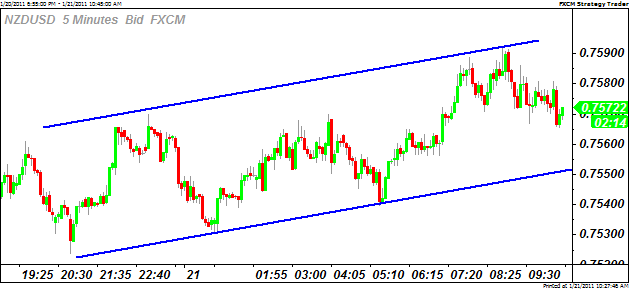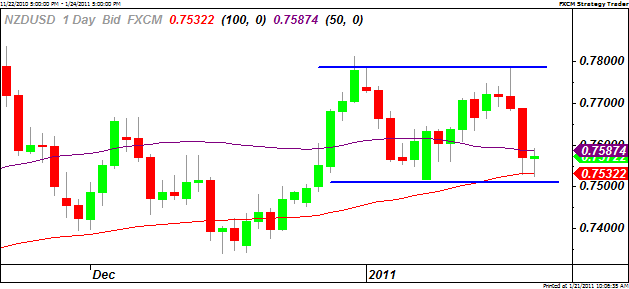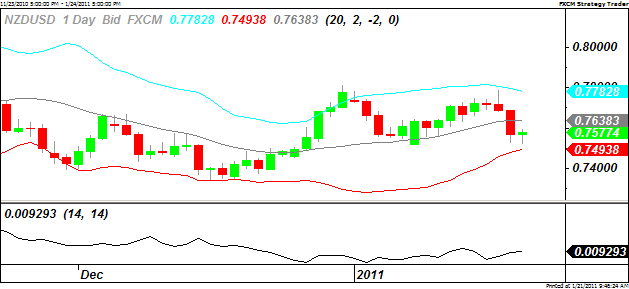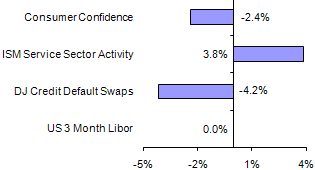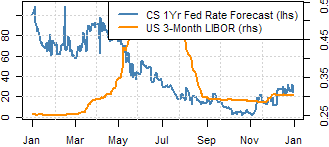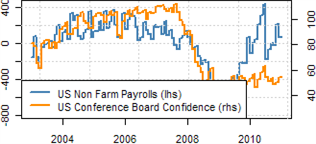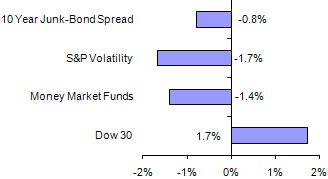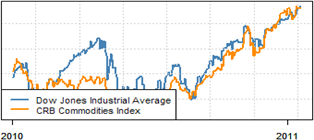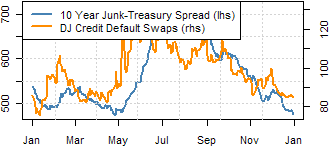http://www.dailyfx.com/forex/fundamental/daily_briefing/session_briefing/us_open/2011/01/21/01-21-11.html
Talking Points
- British Pound: Retail Spending Contracts
- Euro: German Business Confidence Hits Record-High
- Canadian Dollar: Retail Sales To Climb For Six Straight Months
- U.S. Dollar: Weighed By Risk Appetite, U.S. Stocks To Open Higher
The near-term rally in the Euro gathered pace on Friday and the exchange rate may continue to push higher throughout the North American trade as investors raise their appetite for risk. The EUR/USD advanced to a fresh monthly high of 1.3565 as business confidence in Germany rose to a record-high in January, and the pair may continue to retrace the decline from back in November as the outlook for growth and inflation improves. As the euro-dollar crosses back above 1.3500, the 50.0% Fibonacci retracement from the 2009 high to the 2010 low, the pair may work its way towards former support around 1.3700, but the exchange rate may consolidate throughout the remainder of the day as market liquidity going into the weekend.
The IFO business confidence survey unexpectedly increased to 110.3 from a revised 109.8 in December to mark the highest reading since the series began in 1991, while the gauge for future expectations rose to 107.8 during the same period from 106.8 in the previous month. As growth prospects improve, the European Central Bank may turn increasingly hawkish over the coming months, and the central bank may see scope to implement its exit strategy later this year as it maintains its one and only mandate to ensure price stability. However, the near-term rally in the euro could be short-lived as European policy makers maintain a relaxed approach in addressing the sovereign debt crisis, and the single-currency is likely to face additional headwinds over the coming months as the risk for contagion continues to bear down on investor confidence.
The British Pound rallied to a high of 1.5961, but the exchange rate may hold steady going into the North American session as it trades within the previous day’s range. Nevertheless, retail spending in the U.K. slipped 0.3% in December, which was largely in line with expectations, while sales including auto fuel tumbled 0.8% amid forecasts for a 0.2% decline. In turn, private consumption may weaken further over the coming months as households cope with higher inflation paired with the ongoing weakness in the real economy, and the Bank of England may retain its wait-and-see approach throughout the first-half of the year as it aims to balance the risks for the region. As market participants expect economic activity in the fourth quarter to expand at a slower pace, the British Pound may come under pressure over the following week, and the BoE may continue to talk down the risk for inflation as the central bank expects the substantial margin of slack within the real economy to damped price growth.
The greenback weakened across the board on Friday, with the USD/CAD slipping to a low of 0.9951, and the reserve currency may continue to selloff throughout the North American trade as equity futures foreshadow a higher open for the U.S. market. Nevertheless, the Canadian dollar may show a bullish reaction to the retail sales report as market participants expect household spending to expand for the sixth consecutive month, and the dollar-loonie may continue to retrace the advance from earlier this week as the data reinforces an improved outlook for Canada.
Related Articles: Weekly Trading Forecast - 01.17.11
FX Upcoming
| Currency | GMT | EST | Release | Expected | Prior | ||
| CAD | 13:30 | 08:30 | Retail Sales (MoM) (NOV) | 0.4% | 0.8% | ||
| CAD | 13:30 | 08:30 | Retail Sales Less Autos (MoM) (NOV) | 0.4% | 0.9% | ||
| Currency | GMT | Release | Expected | Actual | Comments |
| NZD | 21:30 | Business PMI (DEC) | -- | 53.1 | Highest since June |
| NZD | 21:45 | Retail Sales (MoM) (NOV) | 1.1% | 1.5% | Bounces back from sharp contraction |
| NZD | 21:45 | Retail Sales Ex-Auto (MoM) (NOV) | 0.5% | -0.2% | 2nd straight contraction |
| AUD | 00:30 | Export Price Index (QoQ) (4Q) | -- | -8.1% | 1st contraction in 2010 |
| AUD | 00:30 | Import Price Index (QoQ) (4Q) | -- | -3.8% | |
| AUD | 00:30 | RBA Forex Transaction (AUD) (DEC) | -- | 855M | Highest since June |
| JPY | 04:30 | All Industry Activity Index (MoM) (NOV) | 0.2% | -0.1% | 4th straight contraction |
| EUR | 07:45 | French Business Confidence Indicator (JAN) | -- | 108 | Continues 2010 strength |
| EUR | 07:45 | French Own-Company Production Outlook (JAN) | -- | 16 | Best since Oct ‘10 |
| EUR | 07:45 | French Production Outlook Indicator (JAN) | -- | 10 | Remains at strongest level |
| CHF | 08:00 | Money Supply M3 (YoY) (DEC) | -- | 6.6% | Best since Sept. |
| CHF | 08:00 | Real Estate Index Family Homes (4Q) | -- | 390.0 | Hits a record high |
| EUR | 09:00 | German IFO Busines Climate (JAN) | 109.9 | 110.3 | Remains on record-breaking course. |
| EUR | 09:00 | German IFO Current Assessment (JAN) | 113.2 | 112.8 | |
| EUR | 09:00 | German IFO Expectations (JAN) | 106.5 | 107.8 | |
| GBP | 09:30 | Retail Sales (MOM) (DEC) | -0.3% | -0.3% | Softer than expected figures due to harsh winter conditions. |
| GBP | 09:30 | Retail Sales (YoY) (DEC) | 1.3% | 1.0% | |
| GBP | 09:30 | Retail Sales w/ Auto Fuel (MOM) (DEC) | -0.2% | -0.8% | |
| GBP | 09:30 | Retail Sales w/ Auto Fuel (YoY) (DEC) | 1.1% | 0.0% |
DailyFX provides forex news on the economic reports and political events that influence the currency market.
Learn currency trading with a free practice account and charts from FXCM.
Learn currency trading with a free practice account and charts from FXCM.
